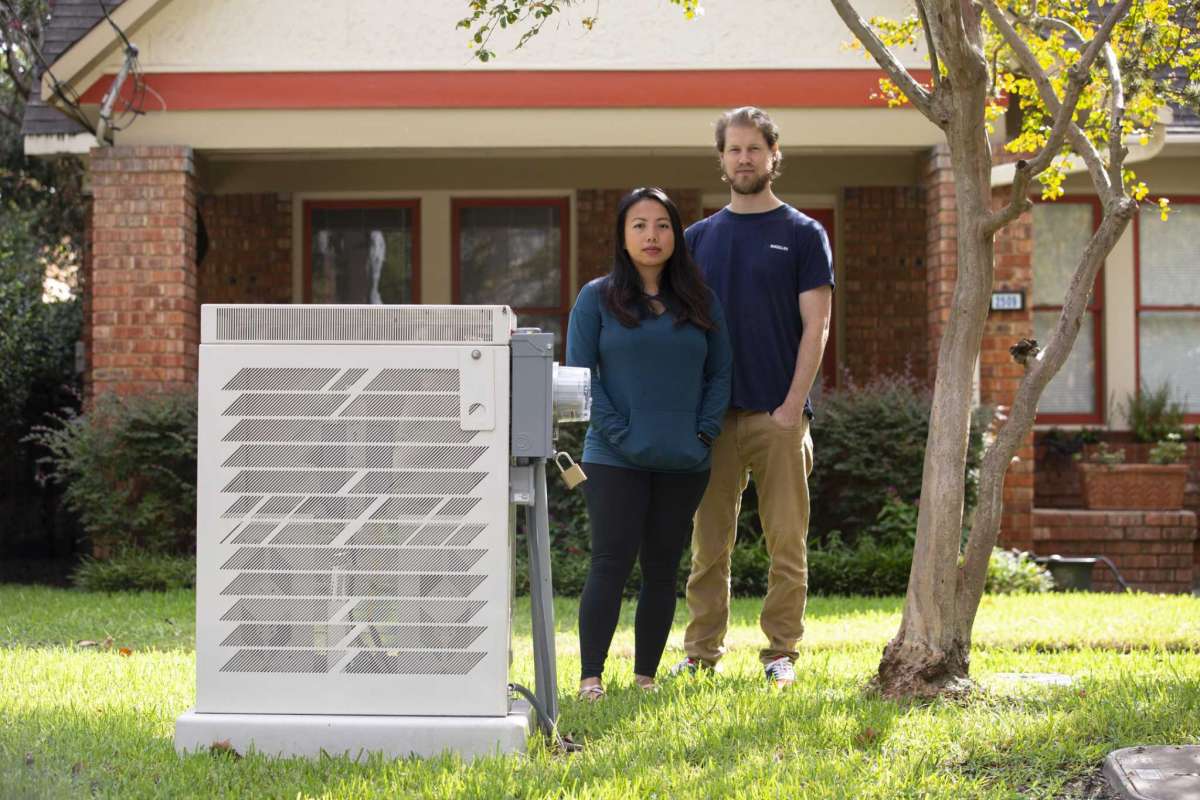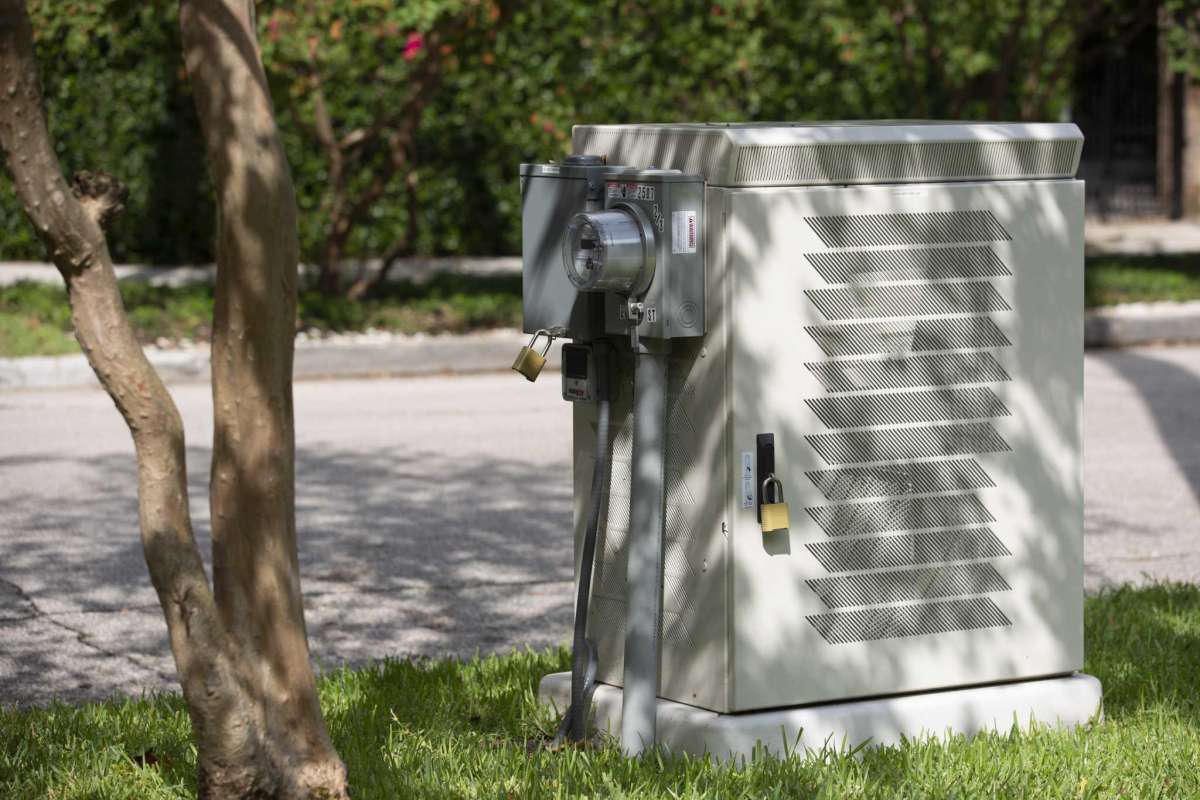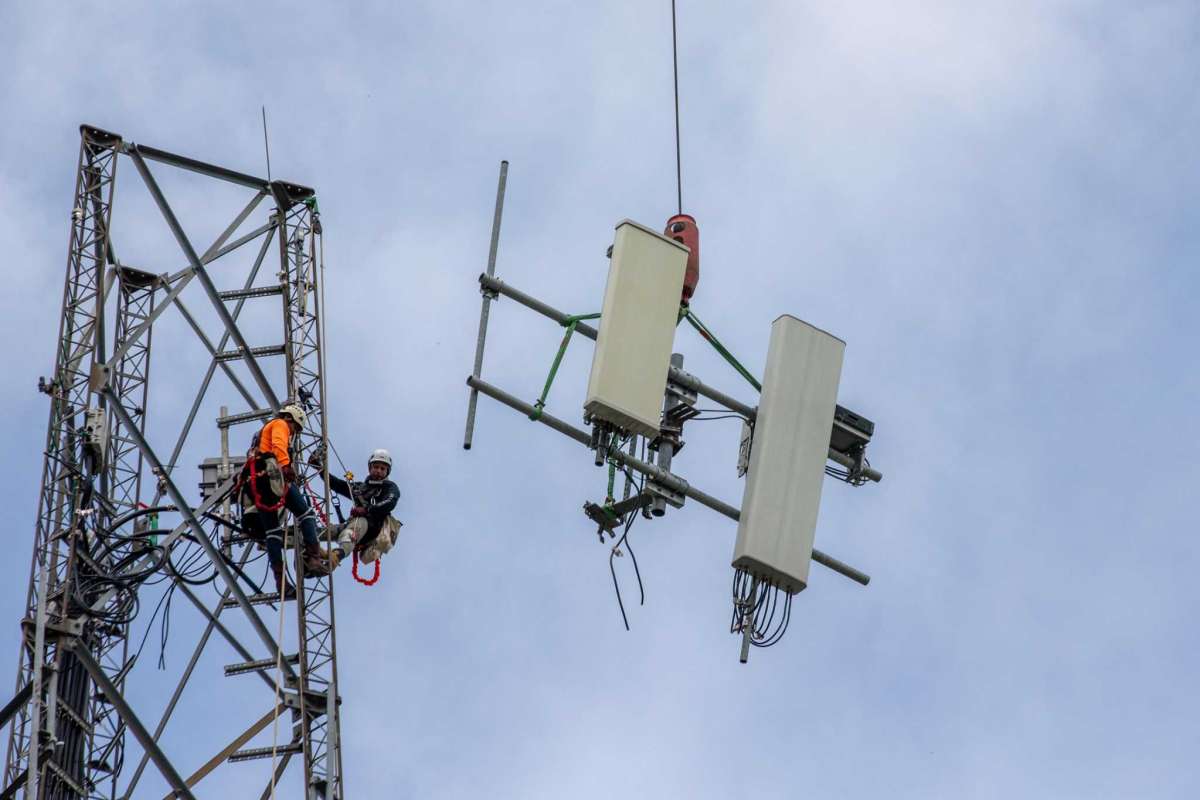‘It’s ugly’: Verizon 5G data boxes appear without notice on Houston front lawns
Dwight Silverman
Houston Chronicle

Dirk Wijnands and Adeline Wijnands-Pang pose for a photograph a 5G junction box in their front yard Friday, Sept. 25, 2020, in Houston. The couple moved into the house about 18 months ago and thought it was the perfect American house with a porch. A few months later, the box was installed without their notice and became an eye sore. But they Photo: Yi-Chin Lee, Houston Chronicle / Staff photographer

5G junction box in Dirk Wijnands and Adeline Wijnands-Pang’s front yard is photographed Friday, Sept. 25, 2020, in Houston. The couple moved into the house about 18 months ago and thought it was the perfect American house with a porch. A few months later, the box was installed without their notice and became an eye sore. But they have Photo: Yi-Chin Lee, Houston Chronicle / Staff photographer

Construction crew disconnect the old transmitters from the tower to be updated with new 5g technology during 5G Infrastructure Installation at Mac Gregor Park area, Tuesday, September 8, 2020, in Houston.Photo: Juan DeLeon/Contributor
Dirk Wijnands and Adeline Pang hadn’t paid much attention to the coming 5G wireless data revolution until its building blocks were installed without warning on the couple’s Montrose-area lawn.
In September 2019, work began on the street near their home on Elmen near Westheimer as contractors dug trenches to install fiber optic cable. Shortly afterward, a box resembling an oversized dorm room refrigerator appeared on their lawn, next to a wooden utility pole that had been placed earlier.
“Three weeks after the work began, they hung a little tag on our doorknob that said something like, ‘Oh we are doing some work on your lawn,’” Wijnands said. “They’d work on it for two or three days in a row, then I wouldn’t see them for five days, and then they’d be back.”
In the jargon of telecommunications, the box is known as “ground furniture.” The beige metal cabinets, with an electrical meter affixed, supply power and a high-speed fiber connection to a transmitter on Verizon’s wireless data network. They are popping up on lawns all over Houston, and in other cities around the United States, often without notice to homeowners.
It is part of the rush to build out the next-generation wireless network called 5G — even if it means ticking off residents. Norman Ewart, a retired lawyer who lives in the Rice Memorial area, said one of the boxes was placed outside his front gate. He complained to Verizon- but the box remains in place.
“It hasn’t been turned on yet, it’s just sitting there,” Ewart said. “I want it gone. It’s ugly, and it devalues my property.”
5G is touted as another disruptive technology, and, as Houston residents like Wijnands, Pang and Ewart have found, it’s not coming without disruptions. Telecommunications companies, device manufacturers, lawmakers and industry associations have promised much faster wireless data speeds, less latency or lag and transformation of the 21st century economy on scale of 4G wireless, which enabled mobile apps that created new services from ride-hailing to video streaming.
To fulfill 5G’s promise, federal and state governments streamlined regulations for permitting and building telecommunications infrastructure such as towers, the transmitters atop them and the fiber optic cables that feed them data. Cities have less control over these networks, resulting in puzzled and unhappy landowners.
The amount of money being spent is mind-boggling. The CTIA, the trade group for the wireless telecommunications industry, estimates the 5G buildout in the United States alone will cost $275 billion; some estimates put the cost as high $300 billion.
5G Primer
5G in the United States works primarily with three types of spectrum, and the way each work determines what kind of equipment is needed to transmit it.
Low-band spectrum, which operates below 1 GHz, is used by all three of the major carriers. These frequencies are also used for 4G LTE, and it has a range of miles but typically has speeds 20 percent to 40 percent better than LTE.
Mid-band spectrum, which operates between 1 GHz and 6 GHz (sometimes called “sub-6”), and has less range than low band but can move data faster. For the moment, only T-Mobile offers 5G in this spectrum, and it acquired it when it merged with Sprint. Mid-band speeds can approach 1 gigabit per second, but typically run in the 200 Mbps to 500 Mbps range.
High-frequency spectrum, called millimeter wave or mmWave, operates between 24 GHz and 39 GHz. It provides the fastest speeds, but also has the shortest range – in some instances, its signal drops at just 1,000 feet from the transmitter. In addition, it can’t penetrate through buildings, glass or even foliage. Verizon and AT&T use mmWave; T-Mobile has it in a few cities, but not yet in Houston. Theoretically, mmWave can carry data up to 6 gigabits per second, or about six times the fastest speed offered by AT&T’s fiber-optic home internet service. Currently, mmWave from Verizon can deliver speeds up to about 2 Gbps.
That doesn’t include the spending to acquire spectrum – the radio frequencies over which wireless services travel. Telecom companies recently bid almost $81 billion for a chunk of spectrum known as C-Band in auctions run by the Federal Communications Commission.
Speed vs. distance
To understand why the 5G buildout is complicated and expensive — and possibly coming to lawn near you — it’s important to know that 5G is not just one technology. Rather, it’s an amalgam of many different ones. It’s how they are assembled and interact that give 5G its promise.
Wireless networks use radio waves, collectively known as the radio spectrum, for transmission and reception. The radio waves operate at different frequencies. Higher frequencies can carry more data faster but don’t travel as far. Lower frequencies have greater range but can’t transmit as much information as fast.
The C-Band spectrum auctioned by the FCC falls in the middle, which is considered the “sweet spot” for 5G as it delivers higher speeds than low frequencies, but its signals can travel further than high frequencies.
As wireless companies build 5G networks, they are using low, middle and high frequencies to optimize speed and range The process of rolling out 5G in the United States involves changes to cellular towers, on-the-ground equipment that provides power and internet connectivity, and the data and network centers used to manage wireless communications.
While low- and mid-band 5G transmitters are often installed on the same kind of towers as the predecessor technology4G LTE, high-frequency transmitters must be lower to the ground and close together.
High-frequency transmission over a large area requires many small cells, a strategy known as densification. Because of its distance and penetration limitations, high frequency transmission has been confined to urban areas, and locations where people gather en masse, such as stadiums or airports.
But that is changing.
Loss of control
Houston was the first city where Verizon sold a version of its 5G service aimed at home users, designed to compete with cable and fiber-optic residential broadband internet access. The service was launched in 2018, when Verizon began installing the “ground furniture” cabinets and putting small-cell transmitters atop utility poles.
Those transmitters deliver Verizon’s high frequency, 5G service, which it markets as Ultrawideband. The service, first offered to areas in or near downtown, has been extended to other neighborhoods near downtown, Midtown and out to the Energy Corridor — almost to Beltway 8.
In the past, cities had greater latitude in controlling where telecommunications equipment was placed in their jurisdictions. But changes made both by the Federal Communications Commission and the Texas Legislature designed to streamline the permitting process has limited what cities can do.
The FCC rules prevented communities, such as Houston, that require utilities to be buried from blocking the construction of above-ground infrastructure and small-cell towers. That’s why Verizon’s boxes pop up in Houston neighborhoods.
A 2017 state law allows telecommunications companies to install the 5G equipment without seeking approval of homeowners or notifying them. That law, along with a subsequent ruling by the FCC, also cut the fees the city could charge for installing a wireless node to $300 from $2,700, hampering the city’s ability to maintain rights-of-way and infrastructure such as utility poles, said Bill Kelly, director of Government Relations for the city of Houston.
“Cities can absolutely be partners in this process” of building out 5G infrastructure, he said. “We can’t continually be on the menu for cuts and seen as an obstacle.”
Houston City Councilman David Robinson, chair of the city’s Transportation, Technology & Infrastructure Committee that oversees telecommunications projects, put it more bluntly.
“It’s another instance of Houston getting the shaft as a municipality,” Robinson said
Waiting for answers
Robinson, who just happens to live near Wijnands’ and Pang’s home, said his main concern is Verizon is not alerting residents before the boxes are placed.
The permits don’t require individuals to be notified, Verizon spokesperson Kate Jay said.
“We are required to work with design districts and historical commissions, but not with individual homeowners,” Jay said via email. “We take all complaints very seriously. Each case is assessed on an individual basis, with many factors going into that assessment. In limited instances, we have determined that there is sufficient reason to move it, and have done so.”
Verizon declined to make executives available for interviews. In a statement, the company said, “We comply fully with all zoning and permitting requirements, and potential antenna locations must meet all local, state and federal regulations. These are placed in the right of way and are properly permitted.”
Elizabeth Kantner, who lives in the Rice Memorial area near Washington Ave., said crews affixed one of the boxes last September in front her home, but not on the ground. Instead, it was mounted on a utility pole, about three feet off the ground. Crews dug up sod underneath it, and then left. An earlier dig broke water mains in the area, she said.
“When they started digging to put in cables, there were two water main breaks that flooded our street,” Kantner said.
After Kantner met with the head of the construction crew, the box was removed and the sod replaced. Looking at her front yard, it’s hard to tell anything was ever there.
But she said the matter is not resolved. Kantner said the contractor told her the box could reappear at any time and would check to see whether it would return or to move to another property.
So far, she said, there’s still no word.
Dwight Silverman is the technology editor for the Houston Chronicle. He manages the TechBurger website, writes about personal technology for HoustonChronicle.com and the print edition. He also writes a weekly tech column, also called TechBurger, and a weekly newsletter, Release Notes.
